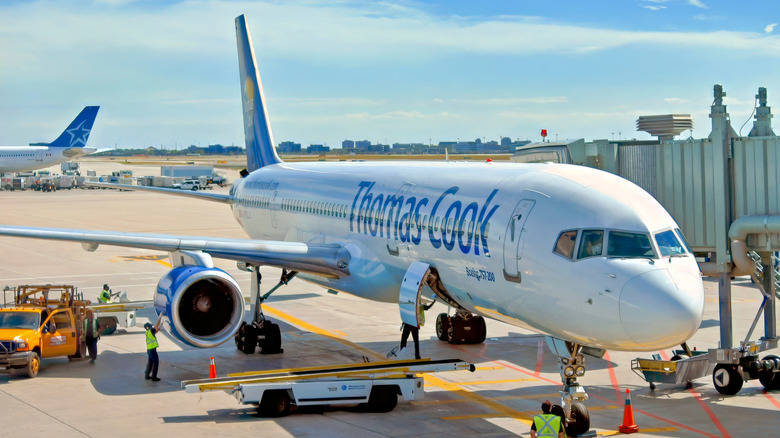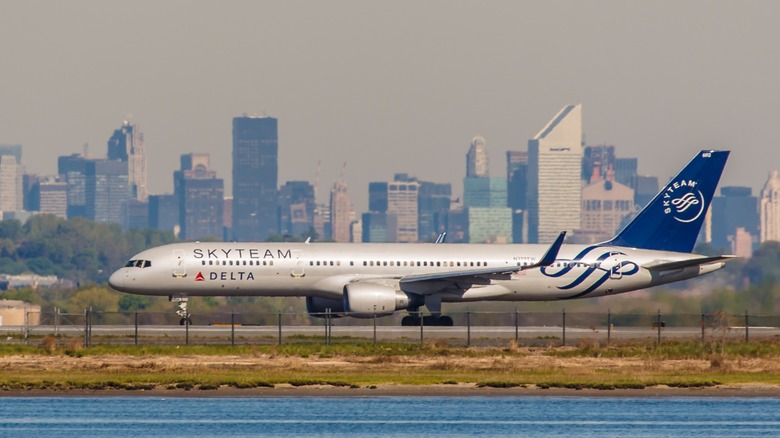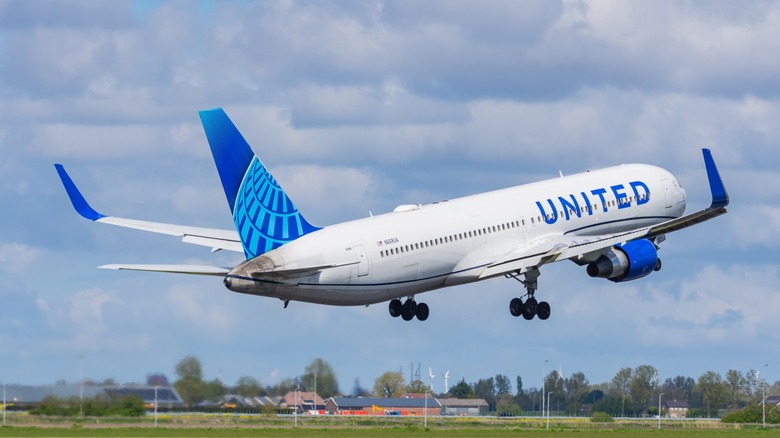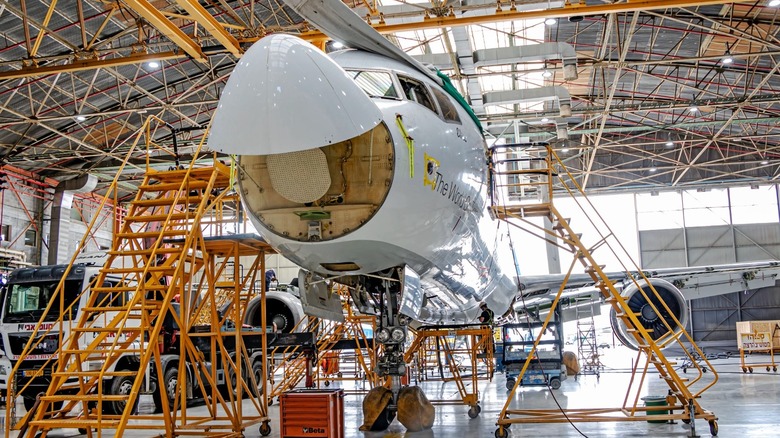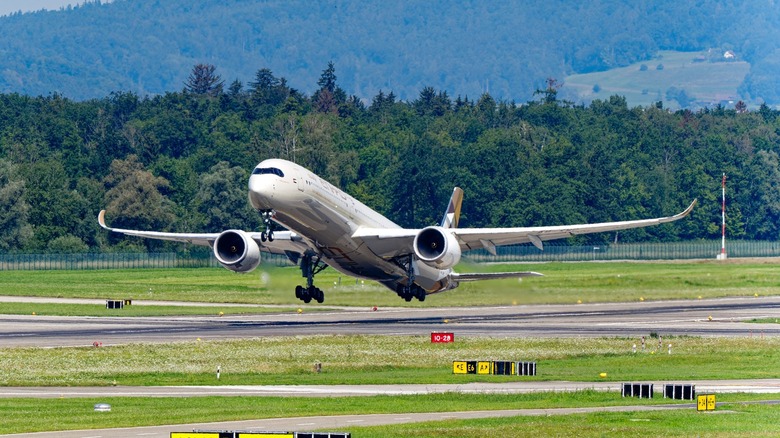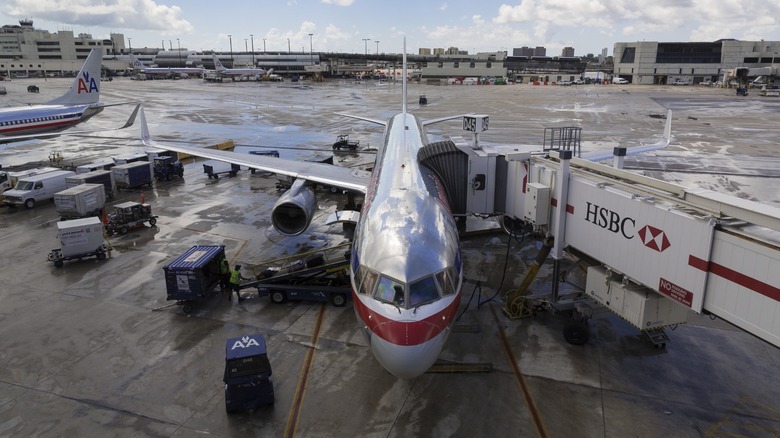Why Are The Boeing 757 And 767 Jets So Similar To Each Other?
The Boeing 757 and 767 are popular twin-jet airliners that both fly intercontinental routes. If you look at both planes from afar, you'd notice that they look eerily similar — especially if they're wearing the same livery. Furthermore, pilots used to flying just one of these jets would find themselves perfectly comfortable in the cockpit of the other, as both planes have identical flight control layouts. This means airlines could save on training costs, as pilots only need one license to fly the single-aisle 757 and wide-body 767, with only one additional course required so that they could fly either jet.
So why did Boeing build these two different jets so similarly? Let's look at the history of the Boeing 757 and the Boeing 767 to see how they were conceptualized, and then look at these jets were developed from concepts on the drawing board into some of the most popular twinjets of their time. We can then check out their differences to see how each of them has served different roles.
A single-aisle twin jet to replace the 727
The 727 was the second jetliner Boeing built after the 707, and it was intended to fly shorter routes from smaller airports. However, by the mid-1970s, the tri-jet was showing its age, so Boeing needed a replacement. Airlines that operated the 727 wanted a new jet with increased capacity, so the initial plan was to stretch the existing model while giving it new wings, engines, and landing gears. That jet would be known as the 727-300. However, airlines also demanded one thing that the 727-derived upgrade would not be able to deliver – better fuel efficiency.
After all, this was just a few years after the 1973 oil crisis, when fuel price sticker shock was still fresh. So, in January 1976, Boeing introduced the 7N7, which was built with two Rolls-Royce engines instead of the three turbines used by the older airliner along with several tweaks to the original design to hit the fuel efficiency targets the airlines required. As the design progressed, the narrow-body jet got away from the older airliner characteristics and started to incorporate technologies also being developed for the 7X7 project, which would eventually become the 767.
A smaller wide-body for the medium-sized market
While the Boeing 747 was a game changer for aviation, its capacity was often too high for routes that served smaller cities. As such, the aircraft manufacturer recognized the need for a smaller wide-body airliner that could serve smaller airports while still having enough range to fly across the Atlantic. This design is actually similar to the Airbus A300, Boeing's number one competitor today, but it was a novel concept for the market in the 1970s.
Boeing launched the wide-body jet in 1978 as the 767, with United Airlines scheduled to be its first customer. It also was supposed to come in three variants: the 767-100, the 767-200, and the trijet 767MR/LR version. However, the 100 variant was dropped because it would directly compete against the narrow body being developed alongside the 767.
Boeing also discontinued the 767MR/LR to focus on the twin-engine development of the 767. Furthermore, improvements in engine technology, which allowed airliners to continue flying even if they lost an engine, allowed for the introduction of ETOPS, or Extended Twin-Engine Operations. This meant that airlines could now use more efficient twin-engine aircraft to cross the Atlantic, instead of relying on three- and four-engine behemoths like the 747 and DC-10.
Parallel development between the 757 and 767
Boeing kicked off the development of both the 757 and 767 in 1978, meaning that it was building two new jets simultaneously. Although the former was originally just an improved version of the already existing 727, market demand meant that the 757's design was soon closer to the 767 than it was to the old trijet.
As mentioned, the 757 and 767 had identical cockpits — this was no mean feat, especially because the wide-body 767 was about four-feet wider than the single-aisle 757. Even though the 757 was supposed to be based on an existing design already, the engineers working on the project still used computer-aided design (CAD) — a technique originally used for the 767 project — for more than 33% of the plane.
Due to the similarities across the two plane types, pilots could fly one or the other one the same license. This made training more affordable and encouraged airlines to buy both models for their fleets. As a result, the Boeing 757 and 767 became popular among airlines, with Boeing's order books totaling 1,049 deliveries for the single-aisle jet and 1,317 for the wide-body. Today, Boeing has delivered a total of 2,366 airframes from the 757 and 767 family — with the company still listing 90 unfilled orders for the 767 as of 2024.
Range and performance differences
Now that we know the development stories of both the 757 and 767, let's check the range and performance differences between the two families. We will only look at the main variants of each model, so, that will be the 757-200 and the 757-300 for the narrowbody jet. For the twin-aisle airliner, we will be assessing the 767-200ER, the 767-300ER, and the 767-400ER.
The Boeing 757-200 has a maximum range of 3,915 nautical miles at full passenger payload, while the larger 757-300 has a shorter 3,190 nautical mile range. This allows both variants to fly across the Atlantic, with the 757-300 capable of reaching London, Paris, and Madrid from New York, and the 757-200 being able to land in Warsaw.
On the other hand, the 767 family has a much farther reach, with the 767-200ER having a range of 6,590 nautical miles. The 767-300ER has a bit shorter reach of just 5,975 nautical miles, while the 767-400ER further reduces this to 5,625 nautical miles. These numbers would allow you to get to far flung destinations from New York. For example, the longest range 767-200ER could fly non-stop to Tokyo, Beijing, Delhi, or Nairobi. The middle range 767-300ER could get to Dubai, while the 767-400ER, which is the shortest range 767, could still get to Moscow, Honolulu, or even Buenos Aires.
Boeing 757 and 767 capacities, compared
Another consideration that airlines have when picking between the two jets is capacity. The base-variant 757-200 has a seating capacity of 200 passengers in the typical two-class configuration. However, if the airline goes for an all-economy layout, you could bump this up to 221 passengers. On the other hand, the larger 757-300 can seat 243 people, with the number of passengers going up to 280 in single-class configuration.
The larger 767 has more seating configurations for a more comfortable passenger experience. The smallest 767-200ER can seat 181 passengers in a three-class configuration, with the capacity going up to 224 with a two-class setup. To maximize the airplane's capacity, it can be set this up to a maximum of 255 seats — about 30 more than the 757-200 and 25 seats less than the 757-300.
The larger 767-300ER will give you 218 seats in the typical three-class layout, but this jumps to 269 passengers when switched to a two-class cabin. It can also go up to 350 seats if it is set at its maximum seating capacity. Finally, the largest 767-400ER can seat 245 passengers in three classes, and 304 passengers in the business/economy class configuration. However, to maximize the number of people on board the plane, the 767-400ER could seat as many as 375 passengers on a single flight.
